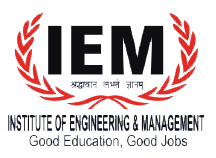| Metric No. | |
| 6.2.1
QlM |
The institutional Strategic/ perspective plan is effectively deployed
Describe one activity successfully implemented based on the strategic plan File Description Strategic Plan and deployment documents on the website Incredible progress has been shown by the Institute of Engineering and Management (IEM) over the past 32 years. The sustainability of IEM has been accomplished by the successful formulation and implementation of strategic/ prospective plans. Strategic Plan
Implementation
Incentive Schemes Grant in Aid Policy: Patent: Revenue Sharing: 50% of patent revenue will be retained by the institute and 50% will be shared amongst the inventors. Reputed Journal Incentive – The institute will give an incentive for publications in journals by faculty members. In the case of a team, the amount shall be shared equally among team members:
Book Publication Incentive: Award for Publications of textbooks in relevant engineering discipline:
Conference Incentive: Each staff member is eligible, twice per year, towards registration and travel expenses for institute recognized list of Conference / Journal/Conferences organized by the IEM-UEM group:
The incentive for Externally Funded Research– The Institute shall pay the research team an incentive equivalent to 5% of the research grants received from external funding agencies Foreign Visits Incentives – Each faculty and a staff member will be eligible for incentives up to 1 lac per visit, 3 times a year, for organizing conferences/ Study Abroad Programmes /Faculty exchange program. 2. Job oriented courses: a. Special Aptitude classes (1120 classes per semester) from 2nd semester onwards to make them ready for placement. b. Industry Visit: Special Industry Visit is frequently conducted at least (two per semester ) to bridge the gap between academia & industry. 3. Certificate Courses: Institute offers certificate courses to encourage the students to learn the emerging technologies as well as subjects included in their curriculum More than 12000 IEM Learning Courses More than 4000 free Coursera Courses More than 500 NPTEL courses 4. IEM-IEDC (Innovation and Entrepreneurship Development Center): In order to comply with the Make in India Policy taken up by the Government of India, the institute encourages the students to explore their innovative minds in the IEM-IEDC lab which eventually encourage many students to start their own Start-Ups and become able entrepreneurs. The institute also provides seed money and office space if required. The institute already has more than 82 start-ups and approximately 68 are in pipeline. 5. Skill development and value-oriented courses: Special classes are conducted as ESP and SDP classes and are included in the routine from the 1st semester itself to make the students aware of those subjects which will eventually help them to get jobs in the future. GATE classes are conducted from the 3rd year. Total approximately 80 such classes are conducted per semester. The link for the relevant documents: Link for the Incentive scheme: Click Here Link of the image Paper Presentation : Click Here Link for List of Campus companies funded and Supported by IEM E-Cell: Click Here Link for writeup for IEM-IEDC Lab : Click Here Link for attendance sheet of Gate & Aptitude class: other years will be updated 2020-21: Click Here |
| 6.2.2
QlM |
The functioning of the institutional bodies is effective and efficient as visible from policies, administrative setup, appointment and service rules, procedures etc.
Describe the Organogram of the Institution Delegations of responsibility – some of the key responsibility areas are identified and delegated at different levels – office function, Principal, HOD, Asst. HOD.
In addition, the institute also has introduced seniority-based and performance-based promotions.
monetary incentives, like, sponsoring registration fees for the faculty members whose papers have been accepted at Seminars and Conferences (including International Conferences) providing the Ph.D. registration fees to the candidates by felicitating the retired staff members and recognizing contributing efforts of those, with at least 2 years of service.
The link for the relevant Documents:
Link for Service Rule for College Employees: Click Here Link for supporting document regarding the Appointment of Professor & Associate professor & Assistant professor: Click Here Link for a flowchart of Administrative Setup: Click Here |
| 6.2.3
QnM |
Implementation of e-governance in areas of operation
Options: A. All of the above B. Any 3 of the above C. Any 2 of the above D. Any 1 of the above E. None of the above Option all of the above
Data Requirements:
Administration Finance and Accounts Student Admission and Support Examination
File Description
Details of implementation of e-governance in areas of operation, Administration etc. Link for the excel sheet: Click Here Link for the screenshot of Academic ERP: Click Here Link for the supporting document of Administration: Click Here Link for Supporting document for finance & Account: Click Here Link for supporting documents regarding Student Admission & support: Click Here Link for Examination system in college: Click Here Link for the pdf of E-governance details of college: Click Here Link for Service Rule for College Employees: Click Here |

